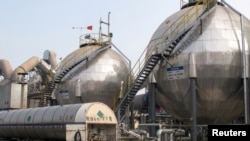Skeptics have said carbon capture has been oversold as a climate change solution so that the fossil fuel industry can keep burning lots of oil, coal and natural gas.
The agreement approved at COP28 in Dubai said the technology could be helpful particularly in “hard-to-abate sectors” like steel manufacturing that are expected to have a difficult time eliminating their emissions. But it wasn’t held up as a way to eliminate the climate impact of fossil fuels.
The agreement “effectively marked the death of (carbon capture and storage) as an energy sector climate solution,” said Ed King, who works with governments and others seeking to speed up action on climate change.
Lili Fuhr, director of the fossil economy program at the Center for International Environmental Law, said COP28 prevented carbon capture from being touted as a technological savior.
“Carbon capture pipedreams were exposed as a massive and dangerous distraction,” she said.
What exactly is carbon capture?
Lots of industrial facilities like coal-fired power plants and ethanol plants produce carbon dioxide. To stop those planet-warming emissions from reaching the atmosphere, businesses can install equipment to separate that gas from all the other gases coming out of the smokestack, and transport it to where it can be permanently stored underground. And even for industries trying to reduce emissions, some are likely to always produce some carbon, like cement manufacturers that use a chemical process that releases CO2.
“We call that a mitigation technology, a way to stop the increased concentrations of CO2 in the atmosphere,” said Karl Hausker, an expert on getting to net-zero emissions at World Resources Institute, a climate-focused nonprofit that supports sharp fossil fuel reductions along with a limited role for carbon capture.
The captured carbon is concentrated into a form that can be transported in a vehicle or through a pipeline to a place where it can be injected underground for long-term storage.
Then there's carbon removal. Instead of capturing carbon from a single, concentrated source, the objective is to remove carbon that's already in the atmosphere. This already happens when forests are restored, for example, but there's a push to deploy technology, too. One type directly captures it from the air, using chemicals to pull out carbon dioxide as air passes through.
For some, carbon removal is essential during a global transition to clean energy that will take years. For example, despite notable gains for electric vehicles in some countries, gas-fired cars will be operating well into the future. And some industries, like shipping and aviation, are challenging to fully decarbonize.
“We have to remove some of what’s in the atmosphere in addition to stopping the emissions,” said Jennifer Pett-Ridge, who leads the federally supported Lawrence Livermore National Laboratory’s carbon initiative in the U.S., the world's second-leading emitter of greenhouse gases.
How is it going?
Many experts say the technology to capture carbon and store it works, but it’s expensive, and it’s still in the early days of deployment.
There are about 40 large-scale carbon capture projects in operation around the world capturing roughly 45 million metric tons of carbon dioxide each year, according to the International Energy Agency. That’s a tiny amount — roughly 0.1% — of the 36.8 billion metric tons emitted globally as tallied by the Global Carbon Project.
The IEA says the history of carbon capture “has largely been one of unmet expectations.” The group analyzed how the world can achieve net zero emissions and its guide path relies heavily on lowering emissions by slashing fossil fuel use. Carbon capture is just a sliver of the solution — less than 10% — but despite its comparatively small role, its expansion is still behind schedule.
The pace of new projects is picking up, but they face significant obstacles. In the United States, there’s opposition to CO2 pipelines that move carbon to storage sites. Safety is one concern; in 2020, a CO2 pipeline in Mississippi ruptured, releasing carbon dioxide that displaced breathable air near the ground and sent dozens of people to hospitals. The federal government is working on improving safety standards.
Companies can also run into difficulty getting permits. South Dakota regulators this year, for example, rejected a construction permit for a 1,300-mile network of CO2 pipelines in the Midwest to move carbon to a storage site in Illinois.
The technology to remove carbon directly from the air exists too, but its broad deployment is even further away and especially costly.
Who's Supporting Carbon Capture?
The American Petroleum Institute says oil and gas will remain a critical energy source for decades, meaning that in order for the world to reduce its carbon emissions, rapidly expanding carbon capture technology is “key to cleaner energy use across the economy.” A check of most oil companies' plans to get to net-zero emissions also finds most of them relying on carbon capture in some way.
The Biden administration wants more investment in carbon capture and removal, too, building off America's comparatively large spending compared with the rest of the world. But it’s an industry that needs subsidies to attract private financing. The Inflation Reduction Act makes tax benefits much more generous. Investors can get a $180 per ton credit for removing carbon from the air and storing it underground, for example. And the Department of Energy has billions to support new projects.
“What we are talking about now is taking a technology that has been proven and has been tested, but applying it much more broadly and also applying it in sectors where there is a higher cost to deploy,” said Jessie Stolark, executive director of the Carbon Capture Coalition, an industry advocacy group.
Investment is picking up. The EPA is considering dozens of applications for wells that can store carbon. And in places like Louisiana and North Dakota, local leaders are fighting to attract projects and investment.
Even left-leaning California has an ambitious climate plan that incorporates carbon capture and removing carbon directly out of the air. Leaders say there’s no other way to get emissions to zero.
Who's against it?
Some environmentalists argue that fossil fuel companies are holding up carbon capture to distract from the need to quickly phase out oil, gas and coal.
“The fossil fuel industry has proven itself to be dangerous and deceptive,” said Shaye Wolf, climate science director at Center for Biological Diversity.
There are other problems. Some projects haven’t met their carbon removal targets. A 2021 U.S. government accountability report said that of eight demonstration projects aimed at capturing and storing carbon from coal plants, just one had started operating at the time the report was published despite hundreds of millions of dollars in funding.
Opponents also note that carbon capture can serve to prolong the life of a polluting plant that would otherwise shut down sooner. That can especially hurt poorer, minority communities that have long lived near heavily polluting facilities.
They also note that most of the carbon captured in the U.S. now eventually gets injected into the ground to force out more oil, a process called enhanced oil recovery.
Hausker said it's essential that governments set policies that force less fossil fuel use — which can then be complemented by carbon capture and carbon removal.
“We aren’t going to ask Exxon, ‘pretty please, stop developing fossil fuels,’” he said.

















Forum